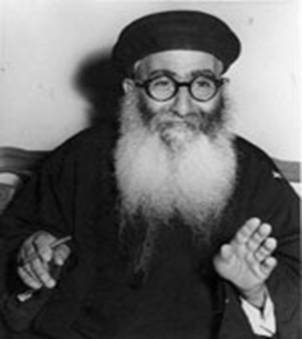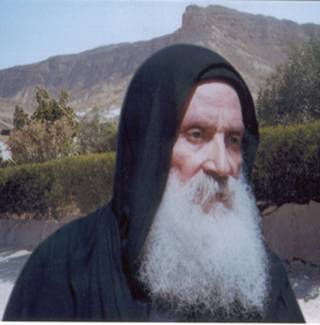|| The Orthodox Faith (Dogma) || Family and Youth || Sermons || Bible Study || Devotional || Spirituals || Fasts & Feasts || Coptics || Religious Education || Monasticism || Seasons || Missiology || Ethics || Ecumenical Relations || Church Music || Pentecost || Miscellaneous || Saints || Church History || Pope Shenouda || Patrology || Canon Law || Lent || Pastoral Theology || Father Matta || Bibles || Iconography || Liturgics || Orthodox Biblical topics || Orthodox articles || St Chrysostom ||
ORTHODOX SPIRITUALITY
Dr. Nos’hi Abdel-Shaheed
Part Three
CHAPTER 1
Historical Development of Orthodox Spirituality (contd.)
The Main Elements of the Orthodox Christian Spirituality (contd.)
1- The scriptural element (contd.):
+ Exegetical [1] Methods and Orthodox Spirituality:
Through the whole evolution of Orthodox thought, the two attitudes towards scripture which already existed in the third century can be traced: The literalist and the historicist attitude of the school of Antioch, and the allegorist and speculative attitude of the school of Alexandria. Besides these two attitudes, which are the attitudes of theologians, there can be noticed all through Orthodox history the existence of spirituality which we might call “evangelical”. This spirituality takes care to identify Christian life neither with the rigorous asceticism of the Desert, nor with ritual worship; it lays stress on the spirit and virtues of the Gospel, on the necessity of following Christ, on charity towards the poor and afflicted. St. John Chrysostom is the most eminent representative of this trend. This practical evangelical spirituality found its most popular expression in the story of St. Nicholas, the bishop of Morah in Greece, in the fourth century. He used to throw a sum of money at night through the window of a poor man whenever that man needed it to help each of his three daughters at their wedding time[2]. (This saint is the origin of the legend of Papa Noel who leaves presents for the children on Christmas eve.)
This evangelical piety is characterized by simplicity of life, humility, mercy for the weak, practical sense, dependence on Christ through confident prayer under all circumstances and for all needs, soberness, and discernment. Millions of Orthodox believers lived this life of piety throughout the ages, not only in the time of the Apostles, but in times of persecution and later at the time of Christian kings in the fourth century, then at the time of non-Orthodox and non-Christian leaders up to our present time. This piety is presented by a long uninterrupted series of personalities, whose enlightening piety has been seen by all, the Church recording their names in her feasts and prayers, asking for their intercessions after their departure from this world. Some of these are martyrs, others are confessors, others are bishops and priests, and others male and female monks and virgins. Also, many of them were regular believers (laity), who were never ordained to priesthood. We like to mention Abba Makarios of the wilderness of Shiheet, Abba Pakhomios the father of communal life, Abba Shenouda the Archimandrite, Abba Bishoy, Abba Moses The Black, Abba Samuel the Confessor, Saint Mary The Egyptian, Saint Marina, and the martyr St. Demiana, the martyrs Barbara and Juliana, and the two unknown wives in Alexandria to whom Saint Makarious the great was sent asking that he might learn from them how they live together in love as is taught in the Gospels, such that they could not differentiate between the children of the one from the other in their daily dealings. And Abba Rowais (14th century) and others, whose names have been registered in the church books throughout the ages, many volumes are not enough to talk about them; and many more whose names were not known, including men, women, and young people, who lived this pious Orthodox life.
+ Examples in the twentieth century:
We remember some of the names that illustrate this kind of piety in our recent era. Abba Abraam the Bishop of Fayoum (Egypt) lived the Gospel in his daily dealings, in his love to all poor people without any discrimination (based on their religion), and in his simplicity. He started an organization for reading the Bible in the city of Fayoum. He used to gather the people daily in the church and read the scriptures with them. Abba Makarious The Third, the late Pope of Alexandria who departed in the year 1945, and Abba Bassilious, the Bishop of Luxor, Esna and Aswan, who departed in the year 1947, and who was known for his humility and love for the poor. And Archdeacon Habib Girgis, Dean of the “Coptic Clerical College” and founder of the Sunday Schools in Egypt, who also taught the first generation of its teachers, and who reposed in the Lord in 1951. Also El-mokadessa (visitor of Jerusalem) Shamah from Girga who reposed in the Lord in 1969, she used to preach in the district of Kaliobeya for many years. Her prayers changed the lives of many men and women and converted them to the spiritual pathway. She used to stay up late at night praying diligently and with great fervency for her children that counted in thousands in Egypt and abroad. And Pope Cyril The Sixth who departed in 1971 and Hegomen Fr. Mikhail Ibrahim who reposed in the Lord in 1976, who lived the Gospel in his true simplicity and confident prayers. And Hegomen Fr. Bishoy Kamel of Alexandria who reposed in the Lord in 1979, who was a living example of a disciple of Christ in his behavior, service, dealings, prayers, sermons, and commentaries on the whole Bible, and who is well-known by many people who lived in the 60s and 70s. And many other priests, monks, and laymen, some of whom we know and some we didn’t personally know[3].
|
|
|
|
Rev. Fr. Hegomen Mikhail Ibrahim |
Rev. Fr. Hegomen Bishoy Kamel |
We like to mention also those from Orthodox Churches, other than the Coptic: Fr. John of Kronstadt in Russia, who reposed in the Lord in 1908. He was a married priest, and an example of “evangelical” piety in simplicity and trusting prayers. He had great spiritual influence on millions of Russian people so that many atheists were converted to faith while attending his prayers. Father Lev Gillet, a “Monk from the Eastern Church”, who reposed in the Lord in 1980 at the age of 80, and who published many books including “Dialogue with the Savior”, “A Day with the Lord”, and “Jesus Prayer”. These books were published again in Arabic by Fr. Bishoy Kamel in the sixties. Of his other books, “The Presence of Christ”, “Our Father”, “The Face of Light”, and “Be My Priest” were translated to Arabic and were published by “Beit El Takris” in the 1970s and 1980s. He was also invited in April 1986 by “Beit El Takris” to visit Egypt and to deliver lectures of Bible Meditations in “Al-Kods Fellowship” of Fagala, Egypt.
Father Lazarus Moore is an Orthodox monk of English Nationality. He joined the Russian Church in Jerusalem in 1940. He reposed in the Lord in 1983 in Alaska at the age of 90. Fr. Lazarus is the author of the booklet “Life of Orthodox Prayers” which provided the seed of the popular book, “The Life of Orthodox Prayer” by Fr. Matthew the Poor, after translating to Arabic the Fathers’ sayings about prayer from Fr. Lazarus Moore booklet, and adding many other Fathers’ sayings from the series of “The Ante-Nicene, Nicene and Post-Nicene Fathers”. Fr. Moore was also invited to visit Egypt by “Beit El Takris” and he gave several lectures at the Fagala center, “Al-Kods Fellowship” (April 1969). There are also many examples, other than what we just mentioned, of thousands of men and women that lived with the same Gospel piety along all ages and that are still living it till now.
It is also worth mentioning that the Orthodox Church movements such as the “Zoe” and “Soteer” in Greece, the movement of the “Lord’s Army” in Romania, the movement of “The Orthodox Youth” in Lebanon and Syria, the movement of “Bogomils” in Bulgaria, and the Coptic “Sunday School Service” since the 1930’s are all, in their core, Evangelical Orthodox movements. We know that the service of Sunday school for youth started initially centered on studying the Bible and becoming Christ’s disciples. Their meetings used to be called “Holy Bible Study meetings” before they changed the name to “Youth meetings”.
(To be contd.)
[1] - Exegesis means Bible Interpretation and explanation.
[2] - See the Coptic Synexarium for the 10th day of Kiahk.
[3] This part was written in 2004. We like to add to these names Hegomen Fr. Matthew The Poor, the spiritual father of the monks of St. Makarios Monastery, who reposed in the Lord June the 8th of 2006, and Mother Ireny, the spiritual mother of the nuns of St. Marcurios Abu Saifin Convent, who reposed in the Lord Oct. the 30th of 2006, as well as many others.
|
|
|
Rev. Fr. Hegomen Matthew The Poor The Spiritual Father of the monks of St. Makarios Monastery |
|| The Orthodox Faith (Dogma) || Family and Youth || Sermons || Bible Study || Devotional || Spirituals || Fasts & Feasts || Coptics || Religious Education || Monasticism || Seasons || Missiology || Ethics || Ecumenical Relations || Church Music || Pentecost || Miscellaneous || Saints || Church History || Pope Shenouda || Patrology || Canon Law || Lent || Pastoral Theology || Father Matta || Bibles || Iconography || Liturgics || Orthodox Biblical topics || Orthodox articles || St Chrysostom ||
|| Bible Study || Biblical topics || Bibles || Orthodox Bible Study || Coptic Bible Study || King James Version || New King James Version || Scripture Nuggets || Index of the Parables and Metaphors of Jesus || Index of the Miracles of Jesus || Index of Doctrines || Index of Charts || Index of Maps || Index of Topical Essays || Index of Word Studies || Colored Maps || Index of Biblical names Notes || Old Testament activities for Sunday School kids || New Testament activities for Sunday School kids || Bible Illustrations || Bible short notes|| Pope Shenouda || Father Matta || Bishop Mattaous || Fr. Tadros Malaty || Bishop Moussa || Bishop Alexander || Habib Gerguis || Bishop Angealos || Metropolitan Bishoy ||
|| Prayer of the First Hour || Third Hour || Sixth Hour || Ninth Hour || Vespers (Eleventh Hour) || Compline (Twelfth Hour) || The First Watch of the midnight prayers || The Second Watch of the midnight prayers || The Third Watch of the midnight prayers || The Prayer of the Veil || Various Prayers from the Agbia || Synaxarium





